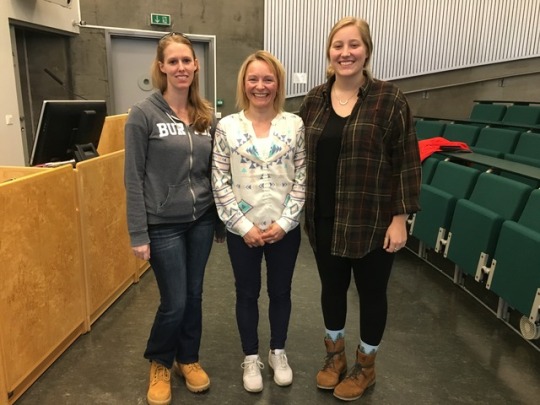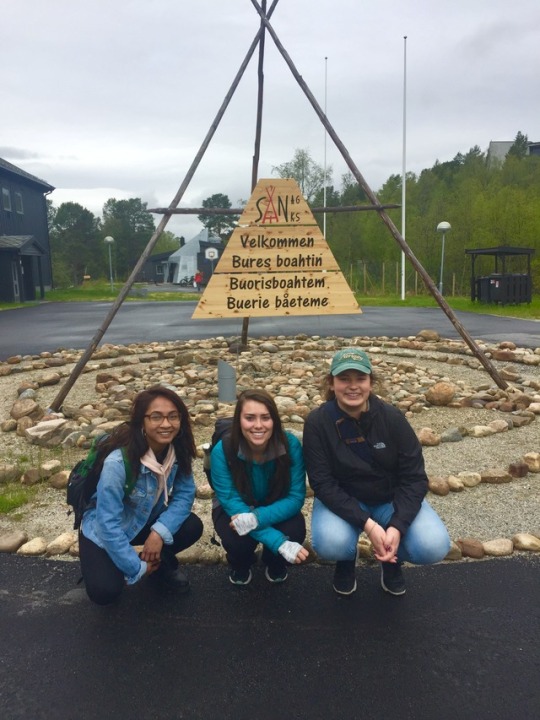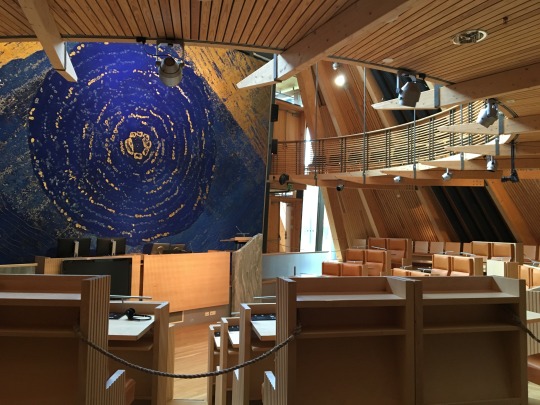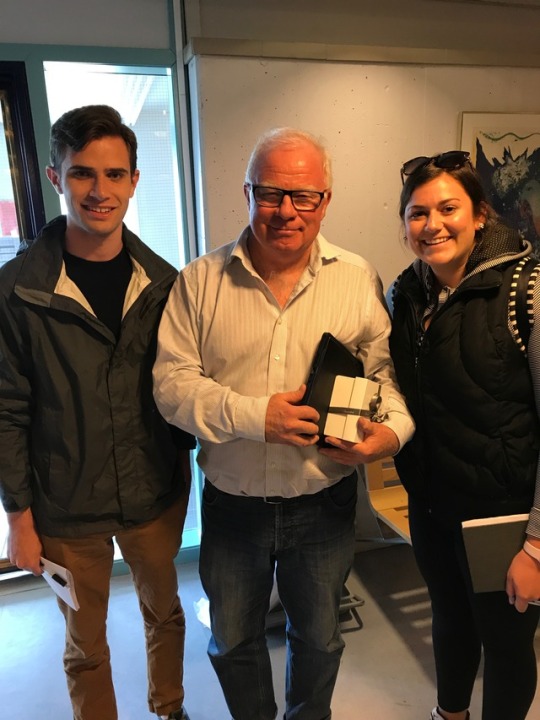Text
Arctic Health Research at UiT
By Karissa and Jake
During our visit at UiT we listened to Jon Odland who had an extensive background in environmental health research and was passionate about climate change and it’s concerning effects on the human race. Jon’s enthusiasm about the Arctic Dilemma stood out to us the most specifically because we never heard about this topic before. The Arctic Dilemma is an issue where the most nutritious foods have the highest levels of contaminants. For indigenous people in particular this is a significant issue because many of their traditional foods are contaminated with toxins that can ultimately lead to poor health outcomes. In an attempt to rectify the Arctic Dilemma, authorities encouraged indigenous populations to stop eating traditional foods such as fish and other arctic mammals. This however lead to the unfortunate side effect of the importation of junk foods that are increasing the levels of diabetes and cardiovascular diseases.
Jon also touched on a different problem dealing with the ethical dilemma of studying indigenous people extensively. This can be a problem when the researchers impinge upon the natives’ way of life. Jon said the best way to deal with this was to work with the population and learn their ways of life as an insider.
Jon works with the AMAP program which is highly involved in the research and monitoring of the Arctic. Climate change poses a threat as it causes an increase in the unpredictability of health risks because of the emerging health problems that come with it. For example, the changing migration patterns among animals changes infectious disease occurrences.
The Arctic Dilemma, the ethical dilemma and climate change are all important issues in public health. As theses problems continue to develop the public health effort needs to keep being vigilant amongst the increasing chaos.
0 notes
Text
University of Northern Norway
By Marc and Rachel:
Visiting the helipad at UNN was a great experience and we were amazed by the system that tracks ambulatory vehicles. It is efficient and the distance from each ambulance to another demonstrates how they are trying to make it easier to reach even the most remote of places. The environment in the arctic results in the need for special equipment and planning from the health care system and they appear to have a well organized system for all of it. It seems like their main dilemma is recruitment and retainment. For example, due to the rule that once a doctor has flown for 7 hours in a day they are not allowed out again, some calls may not be answered. If they had more doctors available that might not be the case and they could provide 24 hour service while giving each team plenty of break.
After visiting the helipad, we received an informative briefing of the administrative side of the UNN healthcare system. From an American perspective, it was very interesting to hear about the finances of a publicly funded hospital. Hospitals back home have become money-making machines, profiting hundreds of millions of dollars annually. This stands in great contrast to the Northern Norway Hospital, which often struggles to stay under its federal budget of 7.2 billion Norwegian krones (around $850 million USD). Only if the hospital stays under budget--which is actually rarely done--can they invest in new medical equipment and facility development. The Norwegians handle this by very carefully coordinating all aspects of daily hospital operations. Hospital administration uses tactics such as implementation of “improvement boards” in all departments to ensure that the hospital staff works cooperatively and towards a common fiscal and quality-related goal.
0 notes
Photo

SAMINOR - Preparing for the Future of Sámi
By: Olivia Hobbs and Linna MacLeod
When looking at the UiT website page, the SAMINOR project seems underwhelming. There is very little information on UiT’s website regarding specifics of the study, rather, they redirect viewers to other webpages. Susanna Siri’s presentation clarified details about the project, while also exposing the study’s magnitude within Northern Norwegian populations, both Sami and non-Sami. Currently serving as a researcher on the SAMINOR team and a PhD candidate at UiT, Mrs. Siri solidified that the project incorporates and utilizes Sami people in its development and execution. Hearing her discuss the project opened our eyes to the comprehensive nature of the study; all aspects of life were included and various research styles were incorporated to obtain a well-rounded view of the Sami population. Similarly, the magnitude of the SAMINOR study became apparent when we got to SANKS in Karasjok. In the SANKS presentations, information from SAMINOR was mentioned and the employees at SANKS knew of Mrs. Siri. We wonder, however, if future SAMINOR studies examine the trends of previous SAMINOR participants over time to determine what changes have occurred and whether policy changes had an influence.
After talking with Mrs. Siri further about the SAMINOR project, she disclosed that the information gathered from the project has already been brought to many Sami municipalities and translated into policies. These policies help to better inform the Sami and non-Sami populations of health issues relevant to the Sami community and encourage prevention efforts in order to reduce health risks in the future. Mrs. Siri hopes that information regarding Sami discrimination will soon be incorporated into the Norwegian school system in an effort to end cyclical discrimination of Sami peoples. Similarly, the information could be utilized by the Sami Parliament in the near future and could extend beyond the Norwegian border into other surrounding Sapmi regions.
0 notes
Text
The Norwegian Center of Rural Medicine at UiT
KC Willmer and Sofia Shirley
In this academic visit, we got to chance to hear from Helen Brandstorp, who is the Director of the Norwegian Centre for Rural Medicine and a RGP. During her 2-hour interactive presentation, she provided an overview of the primary care system in Norway, with a focus on remote medicine. We were very impressed with her emphasis on the patient-doctor relationship, which she definitely described as a two-way street. A close relationship between the patient and the RGP is not only important for continuity and quality of care, but is also cost-effective. We were really surprised that the patients received poorer service when they were farther away from the call centers, which led to a thought-provoking discussion about the expected inequality vs. inequity. Another large challenge she discussed associated with remote Norwegian healthcare was the retention of GPs. Obviously this is an extremely challenging job with often limited resources and huge responsibility, as she told about firsthand from her own experience. Potential solutions to help cope with this stress and thrive on the job include increased collaboration and in situ training. We really loved the way she outlined the simulation procedure to give these medical professionals more experience. They practice with their real teams in their actual workplaces so they have all the tools they would actually need to be successful in these rural areas. She emphasized the point of not only debriefing but also repeating the simulation immediately after, which would greatly enhance performance in similar real-life medical emergencies. Finally, Dr. Brandstorp’s presentation relates back to the field of public health not only because GPs form the foundation of a health system, but also because experts like her can show where created initiatives can eliminate inequity in rural healthcare.
0 notes
Text
SANKS Visit
Legally, all citizens of Norway are entitled to the same health care, but traditional Norwegian health institutions do not meet the needs of indigenous Sámi populations. SANKS addresses these mental health disparities by providing culturally customized treatment. Over half of the employees speak Sámi, which helps build trust and respect. With many diverse cultures in The United States, implementing this strategy would help improve the relationship between doctors and patients in the future.
SANKS is studying the relationship between stress and Sámi reindeer herding. Loss of grazing land and lack of understanding from health professionals are main stresses for reindeer herders. From a public health standpoint, services like stress management and further employee training would benefit the reindeer herder’s well being greatly. However, the loss of land is an issue that cannot be fixed by the health system. Instead, the study conducted by SANKS could serve as a tool for politicians to take further steps in helping protect the Sámi way of life. The institution combines Sámi culture in healing for a reason—it works to validate and empower the people.
SANKS also uses environmental therapy to help patients with mental health issues. Proximity to nature is one of the Sámi core values, and SANKS does this by taking youths on hiking, canoeing, and camping trips every week. On the last day of our trip, we experienced immersing oneself in nature through canoeing. We built cooperation and communication through the experience of paddling and huddling together around the fire, and can see why environmental therapy is used at SANKS.
Though this is a public health course, we also talked about culture, geography, history, and politics. We see that the determinants of health vary, and multiple disciplines must be referenced to provide the best care.
0 notes
Photo

Noury, Ella and Eva at the SANKS entrance. Welcome is written in a variety of Sámi languages.
0 notes
Text
The Sami Parliament of Norway
by Will and Alex
Baikkat ja duhpát leat buorit niegus - historical Sami proverb.
Filth and tobacco are fine in dreams. This and 33 other Sami proverbs decorate the halls of the Sami Parliament in Karasjok, Norway. Symbolizing the traditional Sami laavu tent home, the parliament building unifies the Sami people both through its symbolism and its primary role as the meeting place for Sami politicians.
Contrary to newcomers' assumptions, Sami political parties do not normally participate in the national elections. Politics for the Sami people occur separately from greater Norway; their elections take place once every four years, solely for the election of Sami Parliament members. The parliament does not make legislation or collect taxes. However, it consults with the Norwegian government on Sami matters and participates in the Arctic Counsel and UN Counsel for Indigenous People. The conflict line within the ten Sami parties concerns integration, primarily the balance between central government institutions and Sami government institutions. Its politics are inclusive when it comes to gender and age - there is no minimum age required to run for office, and Elsa Renberg was in fact the first parliament member, paving the way for high levels of female participation.
Public health's role in Sami politics is centralized around the Consultation Procedures Agreement. This stipulates that the Sami Parliament has a right to be consulted by the Norwegian government in matters that may affect them directly. The representative we spoke to emphasized that equality does not only mean equal access to health services. While the Sami Parliament and the Norwegian government may share the goal of ensuring health services in Sami regions are on par with the rest of Norway, equal public health in this arctic area also necessitates that national campaigns for good health become inclusive of Sami people, caretakers become more aware of Sami cultural differences, and that services are adapted to Sami languages.
0 notes
Text
The Center for Development of Institutional and Home Care Services - Keeping Patients Young at Heart
By: Megan MacKenzie, Hannah Mischler, Sarah Raquel Moncrief
The center is nestled among wildflowers and greenery, consisting of several buildings subdivided on the basis of healthcare levels and provisions. We were warmly welcomed and treated to traditional reindeer soup inside a primitive Sami dwelling.
This center welcomes the elderly Sami population living with dementia, regardless of their percentage of Sami heritage. Each building on the property serves as protective dwellings for various stages of illness, depending on the patient’s ability for self-care and medication reliance. Approximately fifty patients reside in the health center and nearby apartments. The center utilizes the help of young adults in the local community and healthcare providers from foreign regions. During our visit, we met young men who organize activities, such as knife sharpening, for the elderly to keep them mentally and physically active.
Dementia causes the patient’s memory to deteriorate, potentially leading them to forget their second languages. Often, the patients only remember how to speak Sami. Although language can be a challenge to delivering healthcare, it also acts as a vehicle by which both traditional medicine men and modern medical providers heal the Sami and preserve their heritage. We also learned how food symbolizes the “Sami way” of living; when patients ate traditional food, they were able to recall their family history and comfortably discuss their health and social wellness. The center also understands the importance of family during a patient’s illness, and includes more than their nuclear family.
Due to the welfare system based on taxpayers, there is no difference between the health of the Sami and Norwegians, while the Sami in Russia face larger health disparities. One future challenge is extending the healthcare network and connecting municipalities. From a public health perspective, we hope to see continual development and integration among health workers and the local population to foster the preservation of Sami culture, language, and traditions.
0 notes
Photo

The interior of the Parliament’s Assembly Hall. The Hall seats all of the Parliament’s members as well all members of the community that care to watch the proceedings.
0 notes
Photo

The exterior of the Parliament’s Assembly Hall. The structure is lined with untreated Russian pine wood that changes color depending on the weather it is exposed to.
0 notes
Photo

View from inside the parliament building’s library with view of the outside.
0 notes
Text
Ii oahppa cáhcái doalvvo- Knowledge will keep you from getting stuck in the mud
By: Celia, Katie, Neophytos
Walking into the foyer of the Sami Parliament building, one sees hundreds of lights suspended from the ceiling and immediately thinks about the stars in the night sky. Along with many other aspects of the building, these lights were chosen to reflect the Sami culture and their personal connection to nature. It was a gift from the Norwegian government to give the Samis a permanent meeting place. It was legitimized by the king with legal protection through a consultation agreement.
There are 39 representatives who vote on the Sami council, which is the president and four advisors. The parties within the parliament represent Samis of different backgrounds and opinions, from reindeer herders to the more modern, assimilated Samis. We believe this illustrates how diverse the Sami culture is, and how it can be subdivided in the same way as other, Western cultures.
Although there are no Sami party seats within the Norwegian parliament, the Sami Parliament is funded entirely by the national government and is always consulted on matters relating to Sami welfare. The Sami representatives from Norway, Sweden, Finland, and Russia meet once a year however only the Norwegian government recognizes and supports their Sami Parliament. We hope that this changes in the near future so that the culture, values, and language of the Samis will be better protected.
As expected, conflicts of interest exist among Sami and other locals. Some of them deal with fishing rights, as well as reindeer herding, where Samis are given more rights than locals. The Samediggi is currently dealing with issues regarding the preservation of their language, cultural heritage, budget, and the mining of stones and minerals and oil rig placement in the Repparfjorden municipality. We think many of these issues can be resolved by working together with the Norwegian government.
0 notes
Text
Sami National Center of Expertise for Mental Health and Substance Abuse
By: Allison Shimmel, Amanda Chen, Maggie Skovran, Hope Watson
SANKS is the main mental health and substance abuse center for the Sami population. In addition to offering in-patient treatment, the center conducts research and development, and provides education about the Sami culture.
The goal for research and development is to search for and deliver knowledge about mental health issues in the Sami population. SANKS also aspires for all healthcare professionals to be involved in research and have their experiences published so the general population can learn from them and build competence. However, their research is limited due to budget restrictions and a reliance on public funding.
This small research, administrative unit has conducted many comparative studies on the Sami versus the non-Sami populations in Northern Norway. Some recent studies focused on violence, social competence, and behavioral problems. Additionally, wilderness therapy and group therapy focus on specific Sami values that are implemented at SANKS to provide culturally sensitive treatment. This means providing access to therapists that are educated in Sami lifestyle and traditional occupations, such as reindeer herding.
The most traditional job of all Sami are the reindeer herdsmen. Here in Northern Norway this is a way of life: the reindeer, the land, and the herdsmen. This life may sound simple to most, but the underpinnings of their lives show a truth in the toil between traditional values and modern pragmatism. Westernized treatments are not equitable for reindeer herdsmen due to their different meaning of time and their unique way of expressing emotions. They typically express their thoughts through storytellings, metaphors, and culturally relevant experiences, that classically trained psychologists lack expertise in.
Only through studying remote populations and incorporating culturally sensitive care, as they are doing at SANKS, can we move forward in delivering rural health care without alienating the foundations of people’s identities.
0 notes



